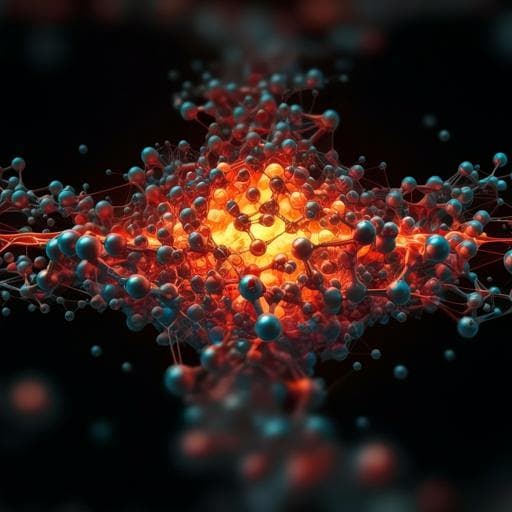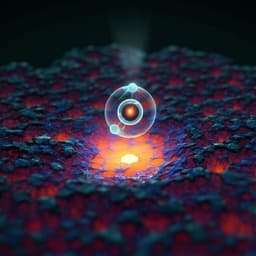
Chemistry
Cooperative Fe sites on transition metal (oxy)hydroxides drive high oxygen evolution activity in base
Y. Ou, L. P. Twight, et al.
Discover how Fe-containing transition-metal (oxy)hydroxides enhance the efficiency of oxygen-evolution reactions in alkaline media. This cutting-edge research reveals a unique interplay between electrochemical history and host material structure, led by prominent authors Yingqing Ou, Liam P. Twight, and others from leading institutions.
~3 min • Beginner • English
Introduction
The study addresses how Fe species from alkaline electrolyte incorporate into Ni and Co (oxy)hydroxide catalysts and which Fe sites are responsible for exceptional oxygen evolution reaction (OER) activity. While Fe is widely recognized to promote OER in alkaline media and is necessary for high activity in Ni/Co (oxy)hydroxides, the dynamic nature and multiple possible local environments for Fe (surface vs interior sites) complicate mechanistic understanding. The authors hypothesize that surface-adsorbed, under-coordinated Fe sites are intrinsically more active than interior, fully coordinated Fe substituents and that cooperative interactions between neighboring surface Fe sites enhance activity. The work aims to control Fe location (surface vs interior) via electrochemical protocols to quantify intrinsic per-Fe activity and elucidate mechanistic underpinnings, thereby informing the design of more active and stable OER catalysts and electrolytes.
Literature Review
Prior work shows Fe is pivotal in promoting OER across diverse materials (oxides, sulfides, selenides, phosphides) and that perovskites reconstruct to Fe-containing oxyhydroxides with enhanced activity in trace-Fe electrolytes. Ni-Fe and Co-Fe hydroxides typically adopt α-phase layered structures with Fe3+ substituting M2+ and charge-compensating intercalated anions; oxidation to γ-MOOH shortens M–O bonds and interlayer distance. The Fe oxidation state during OER has been debated: operando Mössbauer studies reported Fe2+ and Fe3+ under OER, with discrepancies attributed to distinct Fe populations (interior vs under-coordinated surface/edge sites). Previous work by the authors indicated two classes of Fe sites: (1) highly active surface-adsorbed Fe that strongly boosts OER yet minimally affects Ni redox features, and (2) interior Fe that shifts host redox due to strong electronic coupling but adds little activity. Reports of NiFeOOH with surface FeOOH nanoclusters being more active than benchmark Ni-Fe catalysts support the role of surface Fe clusters. However, in most studies Fe site location was uncontrolled, yielding averaged properties that obscure intrinsic activity and cooperative effects.
Methodology
- Catalyst preparation: Hydrated, porous, thin NiOxHy and CoOxHy films were cathodically electrodeposited from nitrate precursors onto Pt/Ti/glass or Pt/Ti-coated QCM crystals. Films (≈5–20 nm thick) are electrolyte-permeable and fully electrochemically accessible.
- Electrochemical protocols: Two approaches to introduce foreign cations from electrolyte were compared.
1) Constant-potential chronoamperometry (CA) at OER potentials (e.g., 1.55 V vs RHE) in Fe-free 1.0 M KOH to establish baseline, then spiking with Fe(NO3)3 to 0.1 ppm to drive rapid Fe adsorption predominantly at surface edge/defect sites while minimizing host restructuring. Analogous CA spiking with Co2+ into NiOxHy and Ni2+ into CoOxHy probed incorporation behavior.
2) Cyclic voltammetry (CV) in metal-ion-spiked electrolyte to promote structural changes and intermixing, yielding more homogeneous substitutional incorporation (interior sites).
- Diagnostics of incorporation site: Host redox peak positions/areas in CV served as proxies: surface-adsorbed foreign phases yield distinct redox waves, while interior substitution shifts host Ni/Co redox peaks. Ni/Co spiking experiments confirmed NiOxHy more readily incorporates foreign cations upon cycling, whereas CoOxHy maintains separate surface phases.
- EQCM and EC-AFM: Monitored mass changes during redox cycling. NiOxHy showed reversible mass increase upon oxidation (~0.33 µg cm−2, ~4.5% of film mass) consistent with ion/water exchange and restructuring; CoOxHy showed minimal change, indicating greater structural stability.
- Fe loading control and quantification: Surface Fe coverage on NiOxHy and CoOxHy was tuned by CA duration in 0.1 ppm Fe3+ solution; Fe loading quantified by ICP-MS after dissolving films. Loading trends with film mass distinguished edge-site adsorption (decreasing at.% with increased Ni loading) from bulk incorporation (approximately constant at.% with cycling).
- Activity measurements: OER currents recorded during iR-compensated CA; TOF metrics computed. TOFFe calculated as O2 formation rate divided by total Fe moles (from ICP-MS). Tafel analysis used stepped currents (0.18–3.2 mA cm−2), holding 3 min per step, across Fe concentrations (10–200 ppb) until maximum OER current (surface Fe saturation) was reached.
- Structural characterization: TEM/EDX mapping on electrodes (including directly on Au TEM grids) to visualize Fe distributions; operando Fe K-edge XAS (XANES/EXAFS) during CA spiking and after CV to assess Fe oxidation state and Fe–O bond lengths/coordination, consistent with small Fe-oxo clusters that contract upon interior incorporation.
- DFT calculations: Spin-polarized DFT+U (VASP, PBE, Ueff: Ni 5.5 eV, Fe 4 eV) models of NiOOH (015) and (001) surfaces with adsorbed Fe sites constructed to compare isolated Fe–O species versus Fe–O–Fe dimers. Multiple OER pathways (axial, equatorial, insertion, bridge) evaluated; overpotentials determined from Gibbs free energies to assess cooperative effects and host substitution (Fe→Ni).
Key Findings
- Site-selective incorporation:
- Under CA at anodic OER potentials with 0.1 ppm Fe3+, Fe adsorbs rapidly on NiOxHy and CoOxHy surfaces (edge/defect sites), producing large OER enhancements without shifting host Ni/Co redox peaks, indicating minimal electronic coupling to interior host sites.
- Subsequent CV induces additional Fe incorporation into interior sites of NiOxHy (positive shift and area change of Ni redox wave), while CoOxHy largely retains surface-separate phases with negligible host redox shifts, consistent with stronger Co–O(H) bonding and structural stability.
- Activity boosts and per-Fe turnover:
- Fe:NiOOH CA-spiked at 1.55 V vs RHE reached ~5 at.% Fe and delivered ~90× higher OER current than Fe-free NiOOH; Fe:CoOxHy showed ~7× enhancement.
- TOFFe (iR-corrected) for Fe:NiOOH increases nearly linearly with surface Fe loading, from ~2.0 ± 0.3 s−1 at 0.7 at.% Fe to 10.4 ± 1.4 s−1 at 5.1 at.% Fe (η = 300 mV). At η = 350 mV, TOFFe peaks at ~40 ± 2 s−1 at maximum surface Fe adsorption, at least ~5× higher than benchmark co-deposited Ni0.75Fe0.25OxHy (~9 s−1 at 350 mV).
- Cycling to incorporate additional interior Fe (up to ~20 at.%) substantially lowers TOFFe, confirming that surface Fe sites are far more active than interior ones.
- On CoOxHy, maximum surface Fe adsorption (~2.4 at.%) yields TOFFe ~0.71 ± 0.08 s−1 at η = 300 mV, much lower than on NiOOH at comparable Fe coverage (~5 s−1 at ~2.5 at.% Fe), revealing strong host-dependent intrinsic activity.
- Electrokinetics:
- Tafel slopes decrease with increased Fe in electrolyte (surface Fe accumulation): for Fe:NiOOH, ~59 mV dec−1 at 10 ppb Fe to ~33–32 mV dec−1 at 100–200 ppb; Fe:CoOxHy shows ~62 mV dec−1 (10 ppb) to ~44–42 mV dec−1 (100–200 ppb). Changes indicate mechanism modulation associated with cooperative surface Fe sites rather than mere site number increase.
- Structural/electrochemical evidence for site location:
- EQCM: NiOxHy exhibits reversible mass gain upon oxidation (~0.33 µg cm−2; ~4.5%), consistent with ion/water intercalation and restructuring conducive to foreign cation intermixing; CoOxHy shows minimal mass change and higher morphological stability.
- XAS: Fe predominantly Fe3+ during CA; EXAFS Fe–O bond length contracts from 1.953 ± 0.004 Å (post-CA surface-Fe) to 1.939 ± 0.011 Å after cycling (more interior incorporation); coordination numbers near 5 suggest small Fe-oxo clusters (larger than dimers, smaller than extended solids).
- ICP-MS vs loading: CA-induced Fe at.% decreases from ~8% to ~3% as Ni loading increases (edge-site-limited adsorption), whereas CV-incorporated Fe remains ~constant (~10 at.%) across loadings (bulk mixing).
- DFT mechanistic insights and cooperativity:
- Isolated surface Fe–O sites on NiOOH show high theoretical overpotentials (η ~0.96 V), whereas Fe–O–Fe dimers substantially lower overpotentials (axial/equatorial ~0.50/0.47 V; bridge pathway lowest, ~0.33 eV), due to shared oxidation (Fe3+→Fe4+ on both Fe) stabilizing key intermediates.
- Substituting one Fe with Ni in the dimer (Fe–O–Ni) raises η (~0.55–0.89 V depending on pathway), indicating the importance of Fe–O–Fe motifs for charge delocalization and low overpotential.
- Similar trends hold on NiOOH (001), supporting generality. Larger clusters may further stabilize intermediates via broader charge delocalization.
Overall, the intrinsic OER activity depends strongly on Fe site location and configuration: surface-adsorbed Fe clusters are vastly more active than interior Fe, and activity per Fe increases with surface Fe density due to cooperative effects.
Discussion
The results directly address where Fe resides during activation and which Fe sites drive OER in Ni/Co (oxy)hydroxides. CA at OER potentials confines Fe largely to surface edge/defect sites, yielding dramatic per-Fe activity increases and linear TOFFe scaling with surface Fe loading until saturation—behavior inconsistent with uniform independent-site models. In contrast, cycling promotes Fe–host intermixing, shifting host redox features and diluting activity by populating less active interior sites. CoOxHy’s structural robustness impedes interior incorporation, keeping Fe at the surface but with lower intrinsic TOFFe than on NiOOH, indicating that the host modulates surface Fe activity through interfacial electronic effects. Electrokinetic trends (decreasing Tafel slopes with Fe loading) and DFT predictions support a cooperative mechanism: neighboring Fe sites in Fe–O–Fe motifs share oxidative charge, stabilizing high-valent intermediates and lowering overpotentials relative to isolated Fe–O sites. This reconciles prior discrepancies about Fe oxidation states and activity by distinguishing multiple Fe populations. The findings emphasize that maximizing OER performance requires engineering not only Fe content but also Fe spatial distribution and local bonding on the catalyst surface, as well as maintaining dynamic equilibrium with electrolyte Fe to sustain active cooperative clusters during operation.
Conclusion
This work establishes a methodology to confine Fe from alkaline electrolytes to surface sites on NiOOH and CoOxHy via chronoamperometry at OER potentials, enabling quantification of intrinsic per-Fe activity and revealing strong cooperative effects among adjacent surface Fe sites. Surface Fe clusters on NiOOH achieve exceptional TOFFe (~40 s−1 at 350 mV), far surpassing co-deposited NiFe phases, while interior Fe is comparatively inactive. Structural/electrochemical diagnostics and DFT calculations demonstrate that Fe–O–Fe motifs lower OER overpotentials by delocalizing oxidative charge across multiple Fe (and to a lesser extent host atoms), with host-dependent efficacy (NiOOH > CoOxHy). Design principles emerge: control Fe site location (surface vs interior), promote formation and maintenance of cooperative Fe–O–Fe clusters, and tune host/support interactions and electrolyte Fe levels to sustain these sites under operating conditions. Future work should resolve the precise structure of active clusters with advanced operando probes, explore host-dependent charge-sharing on Co and other oxides, and optimize catalyst–electrolyte systems to stabilize cooperative Fe sites in practical electrolyzers and photoelectrochemical devices.
Limitations
- Direct electrochemical tracking of Fe redox is not feasible due to overlapping potentials and insulating host states; inference relies on host redox shifts and activity correlations.
- XAS/EXAFS at low Fe loadings provides limited structural resolution; coordination numbers and bond-length changes support small clusters but do not uniquely define cluster size/geometry.
- TEM/EDX sensitivity limits quantification and cannot unambiguously distinguish surface versus interior Fe at low concentrations.
- DFT models consider simplified surfaces (NiOOH (015)/(001)) and small clusters (monomers/dimers); real systems likely exhibit broader distributions of surface geometries and cluster sizes.
- Dynamic Fe dissolution/readsorption and mass-transport effects in operating cells may influence site populations; long-term stability of cooperative sites under cycling requires further study.
Related Publications
Explore these studies to deepen your understanding of the subject.







